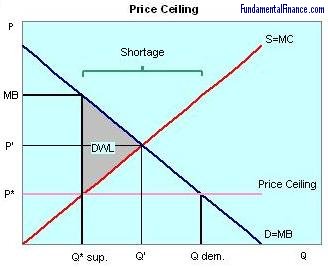A price floor is a government or group imposed price control or limit on how low a price can be charged for a product good commodity or service.
A binding price floor means that.
Price ceilings are common government tools used in regulating.
A minimum wage law is the most common and easily recognizable example of a price floor.
A price floor means that the price of a good or service cannot go lower than the regulated floor.
Graphical representation of tax on buyers and tax on sellers.
A price ceiling is a maximum amount mandated by law that a seller can charge for a product or service.
A price floor is an established lower boundary on the price of a commodity in the market.
A price floor must be higher than the equilibrium price in order to be effective.
The equilibrium price commonly called the market price is the price where economic forces such as supply and demand are balanced and in the absence of external.
A price ceiling means that the price of a good or service cannot go higher than the regulated ceiling.
A price floor is the other common government policy to manipulate supply and demand opposite from a price ceiling.
A binding price floor is a required price that is set above the equilibrium price.
Types of price floors.
Governments usually set up a price floor in order to ensure that the market price of a commodity does not fall below a level that would threaten the financial existence of producers of the commodity.
It s generally applied to consumer staples.
Minimum wage is an example of a wage floor and functions as a minimum price per hour that a worker must be paid as determined by federal and state governments.
Such conditions can occur during periods of high inflation in the event of an investment bubble or in the event of monopoly.
The same concept holds with prices and a price ceiling.
Imagine a balloon floating in your house the balloon cannot go higher than the ceiling.
Floors in wages.
If the price floor is under the equilibrium price economic effects of rent control and minimum wage short run long run per unit tax on buyers sellers and market outcome.










